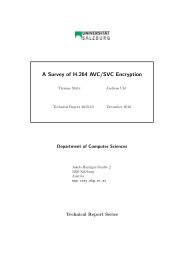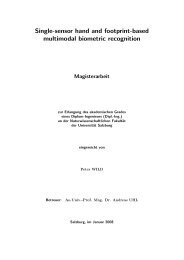Pit Pattern Classification in Colonoscopy using Wavelets - WaveLab
Pit Pattern Classification in Colonoscopy using Wavelets - WaveLab
Pit Pattern Classification in Colonoscopy using Wavelets - WaveLab
You also want an ePaper? Increase the reach of your titles
YUMPU automatically turns print PDFs into web optimized ePapers that Google loves.
5 Results<br />
Feature Feature vector length s k-value for k-NN<br />
BEST-BASIS METHOD (BB)<br />
k-NN (2 classes) Subband energy 1 14<br />
k-NN (6 classes) Subband energy 1 50<br />
SVM (2 classes) Subband energy 8 N/A<br />
SVM (6 classes) Subband energy 41 N/A<br />
BEST-BASIS METHOD (STRUCTURAL FEATURES) (BBS)<br />
k-NN (2 classes) KNNTD N/A 50<br />
k-NN (6 classes) KNNTD N/A 43<br />
SVM (2 classes) FEUNV 14 N/A<br />
SVM (6 classes) FEUNV 30 N/A<br />
BEST-BASIS CENTOIDS (BBCB)<br />
k-NN (2 classes) Subband energy 32 3<br />
k-NN (6 classes) Subband energy 23 33<br />
SVM (2 classes) Subband variance 45 N/A<br />
SVM (6 classes) Subband variance 29 N/A<br />
PYRAMIDAL WAVELET TRANSFORM (WT)<br />
k-NN (2 classes) Subband energy 9 22<br />
k-NN (6 classes) Subband energy 9 25<br />
SVM (2 classes) Subband variance 50 N/A<br />
SVM (6 classes) Subband energy 15 N/A<br />
LOCAL DISCRIMINANT BASES (LDB)<br />
k-NN (2 classes) Subband variance 7 13<br />
k-NN (6 classes) Subband energy 21 14<br />
SVM (2 classes) Subband energy 19 N/A<br />
SVM (6 classes) Subband variance 69 N/A<br />
Table 5.6: Test configuration details for the best results obta<strong>in</strong>ed (<strong>Pit</strong> pattern images)<br />
result of 36%. However, <strong>in</strong> the six classes case the k-NN classifier shows only poor classification<br />
results for the pit pattern types II, III-S and V. For the latter two types this is possibly<br />
due to the limited number of images available for these classes. The SVM classifier however<br />
shows a clearly better classification performance for the pit pattern type II.<br />
The tables 5.8 and 5.9 show the result distribution matrices for the two classes case and<br />
the six classes case, respectively, us<strong>in</strong>g pit pattern images. An entry a i,j <strong>in</strong> such a result<br />
distribution matrix located at row i and column j means, that a i,j percent of the images<br />
belong<strong>in</strong>g to class i have been classified as class-j images. Therefore, a result distribution<br />
matrix for a perfect classification result would be a matrix hav<strong>in</strong>g only values of 100 on the<br />
ma<strong>in</strong> diagonal - thus a diagonal matrix.<br />
Look<strong>in</strong>g at the tables 5.8 and 5.9, we can clearly see that these matrices are far from be-<br />
68








